Spider-view: "Spider-Man/New Warriors: The Hero Killers"
These annuals provide Spidey a new character dimension, offering an entertaining main feature alongside some middling back-up narratives
—by Nathan on December 21, 2023—
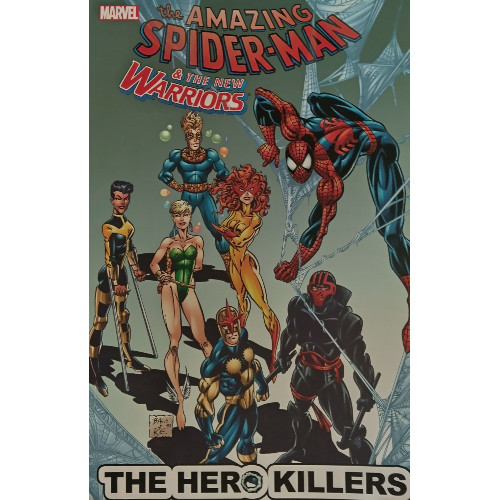
When you think of the allies Spider-Man has worked with over the years, several names come to mind: Daredevil, Wolverine, the Punisher, the Human Torch, even Doctor Strange. Men with powers and weapons, men with philosophies and worldviews different than that of Spidey's. "A ragtag group of teenagers" doesn't often make the list if I were to think through Spidey's various costumed compatriots from across the Marvel Universe. Yeah, he'd side with a punk kid or two from time to time, like Nova or Darkhawk, but playing babysitter to a gaggle of snot-nosed brats? Gedouddahere.
And yet, across four 1992 annuals, Spidey teamed-up with a ragtag group of teenagers known as the Adolescent Justice League–beg pardon? What's that?
This isn't the Adolescent Justice League?
Oh, my bad. Okay, yeah, I see where I went wrong. I took one look at a team consisting of a blond Atlantean warrior, a rich but non-powered vigilante, a fast and wise-cracking teenager, and a space cop given his abilities from a dying alien and got confused for a second. This is the New Warriors. Whoops. Let’s start again.
And yet, across four 1992 annuals, Spidey teamed-up with a ragtag group of teenagers known as the New Warriors (there you go). It's a rather solid idea for a team-up: Spidey was, back in the day, a teenager himself, one of the first teenage heroes who wasn't a sidekick or belonged to a team. It makes sense that this former adolescent superhero, though a solo act for most of his career, would work alongside a group of younger heroes whom he could encourage and influence.
With that in mind, we dive headlong into this four-part story, examining not only this main narrative but some of the bonus tales included in the annuals and seeing how they rank against some other annual adventures I've reviewed.
"The Hero Killers"
Writers: David Michelinie and Fabian Nicieza (main story); Eric Fein, Tom Brevoort, Mike Kanterovich, Glenn Herdling, and G. Alan Barnum (back-up strips)
Pencilers: Scott McDaniel and Brandon Peterson (main story); Aaron Lopresti, Vince Evans, Scott Kolins, Tod Smith, and Steve Buccellato (back-up stips)
Inkers: Keith Williams, Mark Stegbauer, Al Milgrom, and Jimmy Palmiotti (main story); Bruce Jones, Don Hudson, Sam DeLarosa, Aaron Lopresti, and Steve Buccellato (back-up strips)
Colorists: Bob Sharen, Marie Javins, Sarra Mossoff (main story); Kevin Tinsley, John Kalisz, Marie Javins, Steve Buccellato (back-up strips)
Letterers: Steve Dutro (main story); Dave Sharpe, Chris Eliopoulos, and Jon Babcock (back-up strips)
Issues: Amazing Spider-Man Annual #26, Spectacular Spider-Man Annual #12, Web of Spider-Man #8, New Warriors Annual #2
Publication Date: June 1992
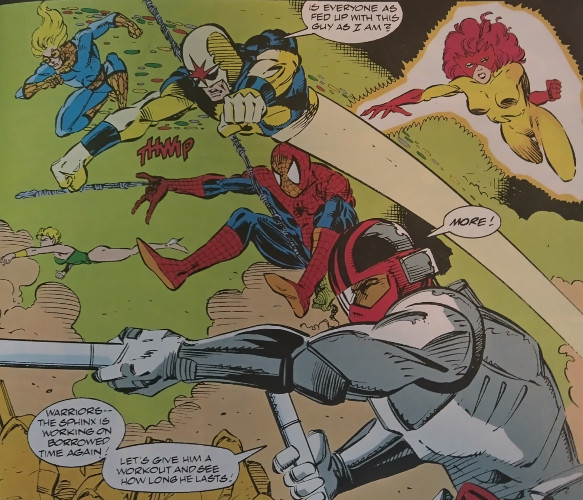
I'm not very familiar with the New Warriors other than what I know from a few scattered stories here and there that reference them (Ben Reilly will join them later on during the "Clone Saga") and whatever encyclopedia entries I've read about them. I do know that Robbie Baldwin (Speedball), a co-creation of Steve Ditko, went a little goofy during the superhuman Civil War and created a costume with 612 internal spikes for the number of casualties from the Stanford explosion that triggered his powers through pain.
I'm sorry, what?
But that's way in the future from where we are now! Yeah, in this story, Speedball gets kidnapped by the powerful Sphinx in a plot to siphon his abilities. When his buddies (and Spidey) come to rescue him, Sphinx captures them and gives them a dose of Speedy’s powers in the hopes they'll bounce around the walls of their prison until (and I quote) they are "nothing but broken bones and bloody!"
Boy, Speedball can't catch a break, can’t he?
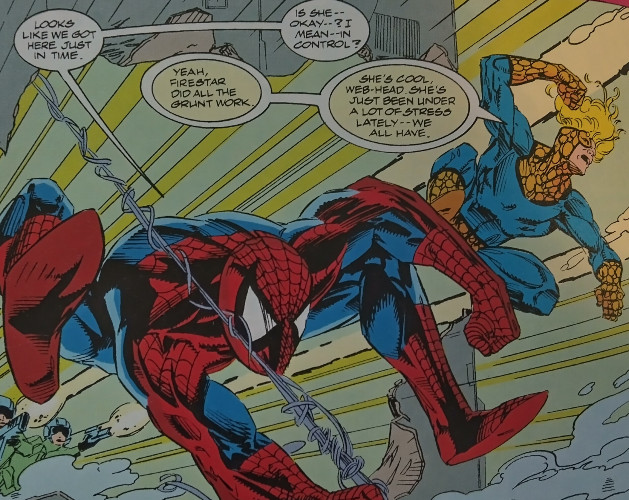
Dark histories of an otherwise fun character aside, these annuals feature our heroes' attempts to rescue Speedball from the Sphinx's clutches, with Spidey joining in a rather half-hearted attempt from writer Michelinie via the old "Let’s get Spidey to converge on the same place as everyone else so our story has forward momentum" cliche. It's a tried if not so true method of bringing characters together, happening often enough in the medium for me to consider giving it a pass before noting that, no, it does feel cheap at times. Once teamed with the heroes, Spidey serves as a sort of mentor character. Michelinie nicely keeps this "mentorship" implicit through Spidey's actions and dialogue; our Web-Head never directly states "Okay, kids I’m in charge now" but makes his experience known through his presence. He's humble enough to receive support from this gaggle of teenage heroes, physically and even emotionally. It makes me wonder if I'm reading too much into Michelinie's intentions, but the feeling I get is that Spidey is a sort of leader to these teenagers throughout the story, with Michelinie allowing the reader's perceptions and understanding of Spidey's character to fill in whatever he doesn’t state directly. If that is the case, I like it.
"Spidey as leader" isn't an often used trope in comics. Spidey is mostly portrayed as the long-suffering loner, and when he does join teams, most times it's with a group that already has a de facto team leader like Mr. Fantastic or Captain America. Whenever he has the chance to lead a team, his under-confidence and inexperience in such a position leads to greater peril or risky behavior, despite his best intentions to see everybody through safely. He certainly sets himself as one of the more level-headed individuals within a team, particularly when paired with killers like the Punisher, mercenaries like Silver Sable, vigilantes like Cardiac, or even villains-turned-anti-heroes like Venom. But he's generally situated on equal footing with everyone else. I applaud Michelinie and Nicieza's work here, for making Spidey that uneasy leader who tries to fight supervillains and keep everyone safe at the same time. The situation adds to Spidey's character, allowing a different dimension to his personality than we've previously seen.
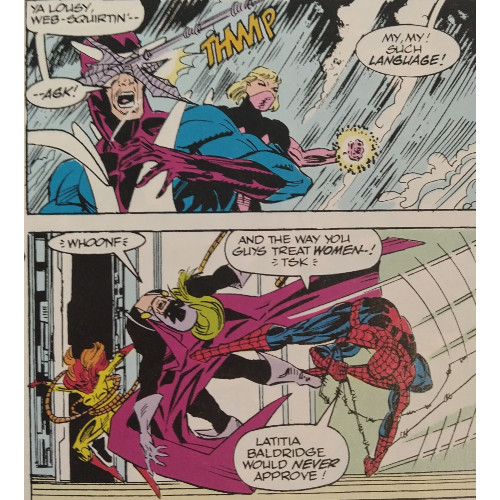
Michelinie and Fabian Nicieza (then-New Warriors writer) do this through a series of pitched battles which fortunately don't blend together during the extended issues. The heroes go up against Dreadnaughts and supervillains alike, with each character receiving action-packed moments to use their powers and show their stuff against the hordes of villains they face. These battles are, unavoidably, littered with coincidences and deus ex machina moments, but they're surprisingly entertaining. Michelinie even gives an indirect nod to the Deadly Foes of Spider-Man series as Justin Hammer employs several villains from that series and utilizes them against the heroes for the Sphinx's purposes.
Nicieza wraps the story up and, aside from a rather forced message about responsibility in the final annual's last page, does a good job writing a solid finale. I prefer Nicieza's dialogue over Michelinie's any day of the week; his style is fluid and humorous, punchy one-liners and pithy sentiments naturally flowing from characters' mouths instead of feeling overused or hammy. You don't really learn anything new about the characters, nor are you given any great insights into what makes our heroes tick aside from instances of "We're all in this together!" rhetoric. But Nicieza's work is fun to read nevertheless.
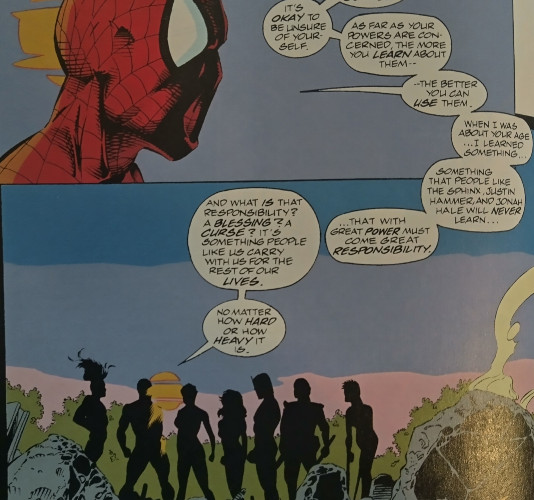
In other moments, commentary is injected, rather subtly. The saga as a whole is driven by illegal experimentation on superhuman individuals, calling to mind other stories where Spidey battled selfish corporations putting their profits before their personal responsibilities. There's a sense that the New Warriors, specifically, represented a younger, more socially conscious generation of heroes…but both writers maintain that, fortunately, Spidey's no slouch when it comes to defending what he believes is right. He may be a tad older, but he's not one of those backwards-thinking folks who remember the good old days when you could just whip up a superhuman serum and stick it into the arm of any willing volunteer. We've got procedures these days, don'tcha know? What kinda weirdo just tells the government they can stick a needle in his arm and inject him with a newly devised chemical compound?
Each annual is equipped with back-up stories written and illustrated by a variety of creators. Unlike with other annuals, I'm not as familiar with the host of talent compiled here. For the Spider-Man annuals, we’re offered longer stories concerning Venom and Cloak and Dagger and a few smaller tales. None of these back-up narratives are overly interesting, which is a shame but seems par for the course when considering tiny tales often packed in at the end of these extended issues.
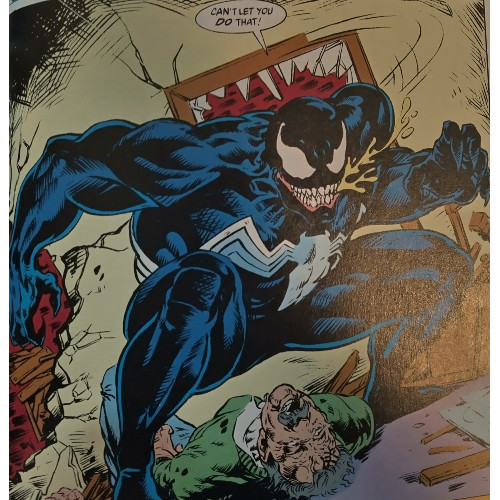
The Venom story, written by Venom co-creator David Michelinie, tries its hardest to convince the reader that Venom's "Lethal Protector" aspect of his identity existed from the very first day the symbiote bonded with Eddie Brock. He ends up killing a criminal, but it's because that criminal's actions led to the death of an old man, so it's okay! Murder is cool when it's in the name of justice. Eddie also tries to get the old man's nephew, a petty crook himself, to turn over a new leaf, espousing lessons about correctly using whatever second chances you're given; this is real rich coming from a guy who dedicated his second chance (and his third…and his fourth…) to murdering Spider-Man. The story becomes this odd, retroactive assertion of some of Venom's developing characteristics. I don't mind Venom's transition from out-and-out villain to quasi-hero, but I don't believe for a second that Michelinie intended the villain to have these more heroic qualities from the moment Eddie Brock and the alien bonded.
The Cloak and Dagger narrative sees the pair going up against the villainous Lightmaster and employs pretty much every trope you've ever encountered if you've read other Cloak and Dagger stories from this time period: Cloak, hungering for light, swallows a couple of thugs in his cape and threatens to snuff them out. Dagger pleads for him to let them go before he kills them, and Cloak obliges. That's basically it. As discussed elsewhere, every Cloak and Dagger story I've read does the same thing, meaning this tale just lacks any uniqueness.
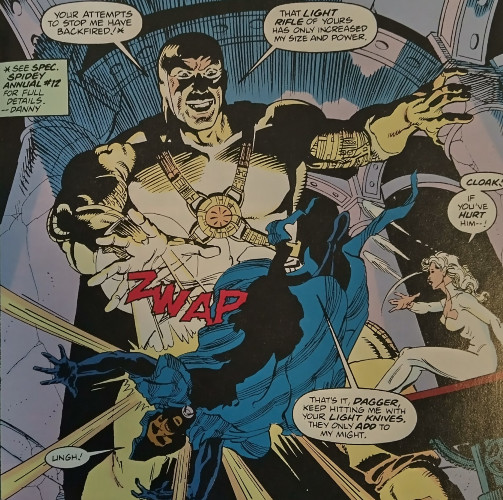
The assorted smaller tales concern the Black Cat, the Prowler, assassin Solo, and several strips about Spidey himself. Again, these are just a handful of mediocre strips predicated on poor writing and narratives that would be potentially interesting where they given more space to flourish. As a result, almost all of the bonus content ends up being only mildly entertaining. The Venom and Prowler stories end with reminders to check out their upcoming limited series, and the Cloak and Dagger tale lets readers know they will be appearing in future New Warriors issues. These reminders make the stories feel more like advertisements for other series than standalone tales to be read for pure enjoyment.
The back-up strips included in the New Warriors annual, short pieces by Nicieza examining each member of the team, are more entertaining. Though they're steeped in New Warrior history and make you feel like you're entering in the middle of certain stories–references to an underwater battle between Namorita and a mercenary called Sea Urchin, for example, were completely lost on me–Nicieza does a nice job using these stories to propel narratives forward. Some may argue that a back-up strip in New Warriors Annual #2 wasn’t the place for readers to learn that Speedball's parents were getting divorced (man, being Speedball sucks) or that Firestar's dad lost his job, but I like that Nicieza took his limited page count and actually did something of substance with the space provided.
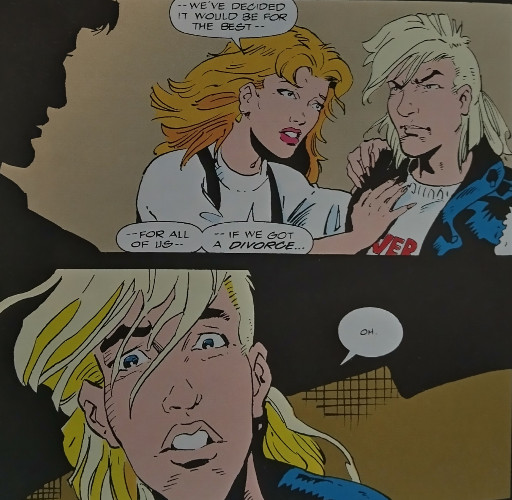
"Substance" isn't really a word I can apply to the rest of this story. The "Hero Killers" portion is entertaining enough (even if the story's only death occurs off-page) and features some good art from Scott McDaniel and well-written dialogue from Nicieza. We see the ever-loving Spidey in an uncomfortable position of leadership, and though he doesn’t really grow as a character from the experience, I always like when writers place him outside of his comfort zone. The idea is certainly more intriguing and less beaten to death than "Spidey tells the Punisher not to kill anyone for the hundredth time." I still don’t know much about the New Warriors after this story, but I can certainly see that Fabian Nicieza was invested in these characters during the 90s and seemed willing to work with them.
Let's just hope somebody someday cuts Speedball a break.